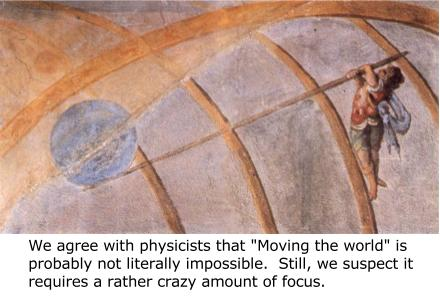A bit about our last few months:
- We’ve been working on getting a simple clear mission and an organization that actually works. We think of our goal as analogous to the transition that the old Singularity Institute underwent under Lukeprog (during which chaos was replaced by a simple, intelligible structure that made it easier to turn effort into forward motion).
- As part of that, we’ll need to find a way to be intelligible.
- This is the first of several blog posts aimed at causing our new form to be visible from outside. (If you're in the Bay Area, you can also come meet us at tonight's open house.) (We'll be talking more about the causes of this mission-change; the extent to which it is in fact a change, etc. in an upcoming post.)
-
We care a lot about AI Safety efforts in particular, and about otherwise increasing the odds that humanity reaches the stars.
-
Also, we[1] believe such efforts are bottlenecked more by our collective epistemology, than by the number of people who verbally endorse or act on "AI Safety", or any other "spreadable viewpoint" disconnected from its derivation.
-
Our aim is therefore to find ways of improving both individual thinking skill, and the modes of thinking and social fabric that allow people to think together. And to do this among the relatively small sets of people tackling existential risk.
Existential wins and AI safety
Who we’re focusing on, why
- AI and machine learning graduate students, researchers, project-managers, etc. who care; who can think; and who are interested in thinking better;
- Students and others affiliated with the “Effective Altruism” movement, who are looking to direct their careers in ways that can do the most good;
- Rationality geeks, who are interested in seriously working to understand how the heck thinking works when it works, and how to make it work even in domains as confusing as AI safety.
Brier-boosting, not Signal-boosting

- Further discussion of CFAR’s focus on AI safety, and the good things folks wanted from “cause neutrality”
- CFAR's mission statement (link post, linking to our website).
A few nitpicks on choice of "Brier-boosting" as a description of CFAR's approach:
Predictive power is maximized when Brier score is minimized
Brier score is the sum of differences between probabilities assigned to events and indicator variables that are are 1 or 0 according to whether the event did or did not occur. Good calibration therefore corresponds to minimizing Brier score rather than maximizing it, and "Brier-boosting" suggests maximization.
What's referred to as "quadratic score" is essentially the same as the negative of Brier score, and so maximizing quadratic score corresponds to maximizing predictive power.
Brier score fails to capture our intuitions about assignment of small probabilities
A more substantive point is that even though the Brier score is minimized by being well-calibrated, the way in which it varies with the probability assigned to an event does not correspond to our intuitions about how good a probabilistic prediction is. For example, suppose four observers A, B, C and D assigned probabilities 0.5, 0.4, 0.01 and 0.000001 (respectively) to an event E occurring and the event turns out to occur. Intuitively, B's prediction is only slightly worse than A's prediction, whereas D's prediction is much worse than C's prediction. But the difference between the increase in B's Brier score and A's Brier score is 0.36 - 0.25 = 0.11, which is much larger than corresponding difference for D and C, which is approximately 0.02.
Brier score is not constant across mathematically equivalent formulations of the same prediction
Suppose that a basketball player is to make three free throws, observer A predicts that the player makes each one with probability p and suppose that observer B accepts observer A's estimate and notes that this implies that the probability that the player makes all three free throws is p^3, and so makes that prediction.
Then if the player makes all three free throws, observer A's Brier score increases by
3*(1 - p)^2
while observer B's Brier score increases by
(1 - p^3)^2
But these two expressions are not equal in general, e.g. for p = 0.9 the first is 0.03 and the second is 0.073441. So changes to Brier score depend on the formulation of a prediction as opposed to the prediction itself.
======
The logarithmic scoring rule handles small probabilities well, and is invariant under changing the representation of a prediction, and so is preferred. I first learned of this from Eliezer's essay A Technical Explanation of a Technical Explanation.
Minimizing logarithmic score is equivalent to maximizing the likelihood function for logistic regression / binary classification. Unfortunately, the phrase "likelihood boosting" has one more syllable than "Brier boosting" and doesn't have same alliterative ring to it, so I don't have an actionable alternative suggestion :P.
I don't think the first problem is a big deal. No-one worries about "I boosted that from a Priority 3 to a Priority 1 bug".